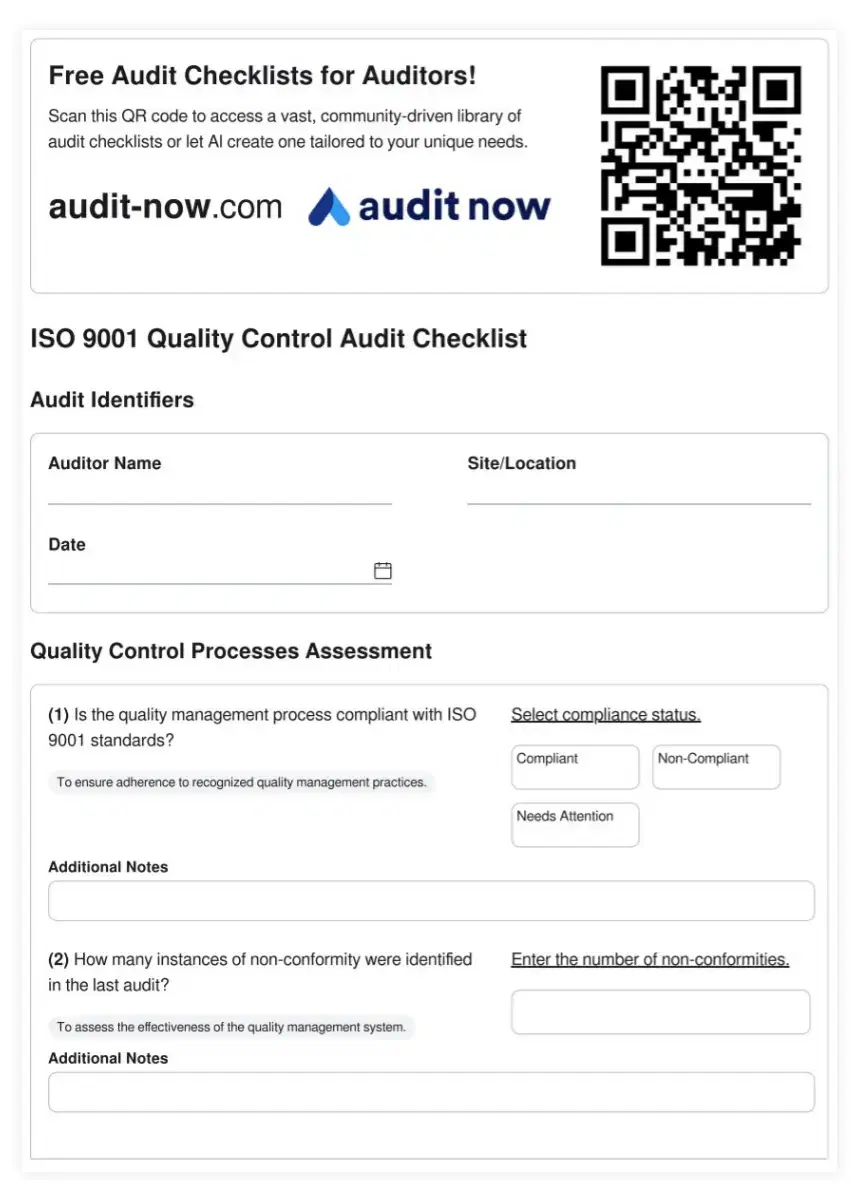Medical Device Engineer Checklists

Featured Checklist

Medical Device Risk Evaluation Checklist
The Medical Device Risk Evaluation Checklist is a vital tool for healthcare organizations committed to adhering to ISO 14971 standards. This checklist assists in the systematic evaluation of risks associated with medical devices, ensuring that all potential hazards are thoroughly assessed and prioritized. By employing this checklist, healthcare providers can enhance device safety, ensure regulatory compliance, and improve patient care outcomes. Keywords: risk evaluation, ISO 14971 compliance, medical device assessment, healthcare safety.
Medical Device Engineer Operational Overview
Medical device engineers face unique operational challenges in their quest to develop safe, effective, and innovative healthcare solutions. Balancing stringent regulatory requirements with cutting-edge technology and patient needs demands meticulous attention to detail. Engineers must navigate complex design processes, rigorous testing protocols, and ever-evolving industry standards.
These operational hurdles directly impact business outcomes, influencing product development timelines, market approval, and ultimately, patient safety. Effective quality management is the cornerstone of success in this field, ensuring that devices meet or exceed regulatory standards while delivering optimal performance and reliability.
To maintain operational excellence and regulatory compliance, thorough auditing practices are essential for medical device engineers.
Core Audit Requirements & Checklist Importance
Audits in medical device engineering encompass a wide range of critical areas, from design controls to risk management and post-market surveillance. Systematic checklists play a vital role in ensuring that no crucial aspect is overlooked during the audit process. These tools help engineers maintain consistency, track progress, and identify potential issues before they escalate.
Compliance requirements in the medical device industry are stringent and multifaceted. Regulatory bodies such as the FDA and EU MDR mandate comprehensive documentation, traceability, and adherence to quality management systems. Checklists serve as a roadmap for engineers to navigate these complex requirements, ensuring that all necessary steps are taken and properly documented.
By implementing robust audit checklists, medical device engineers can streamline their processes, reduce errors, and demonstrate due diligence to regulatory authorities. This proactive approach not only enhances product quality but also builds trust with healthcare providers and patients.
- Design Control Documentation: Verify all design inputs, outputs, and validation records
- Risk Management: Assess hazard identification, risk analysis, and mitigation strategies
- Manufacturing Process Validation: Evaluate production controls and quality assurance measures
- Supplier Management: Review supplier qualifications and component traceability
- Post-Market Surveillance: Check systems for monitoring device performance and handling complaints
Navigating Regulatory Complexities
Medical device engineers must stay abreast of evolving regulatory landscapes across different markets. The FDA's Quality System Regulation (QSR) in the US, the EU's Medical Device Regulation (MDR), and ISO 13485 standards present a complex web of requirements. Engineers need to ensure their devices comply with these regulations while also considering market-specific nuances.
Best practices in regulatory navigation include maintaining a comprehensive regulatory strategy, conducting thorough gap analyses, and implementing robust change management processes. Quality control measures such as design reviews, verification and validation testing, and thorough documentation are critical for demonstrating compliance and device safety.
By adopting a proactive approach to regulatory challenges, medical device engineers can streamline the approval process and bring innovative products to market more efficiently.
Optimizing Design and Development Processes
Process optimization in medical device engineering focuses on streamlining the design and development lifecycle while maintaining rigorous quality standards. This involves implementing lean methodologies, leveraging digital tools for collaboration, and adopting agile development practices where appropriate. For example, using simulation software for early-stage prototyping can reduce physical testing iterations and accelerate development timelines.
Risk management is integral to the design process, requiring engineers to identify potential hazards, assess their impact, and implement effective mitigation strategies. This might involve conducting Failure Mode and Effects Analysis (FMEA) or utilizing risk assessment matrices to prioritize and address potential issues systematically.
Key performance metrics for medical device engineers include time-to-market, first-pass yield rates, and post-market surveillance data. By tracking these metrics and continuously refining processes, engineers can drive improvements in product quality, regulatory compliance, and overall operational efficiency.
Digital Transformation with Audit Now
Embracing digital solutions can significantly enhance the audit process for medical device engineers. Audit Now offers AI-powered checklists that adapt to specific device types and regulatory requirements, ensuring comprehensive coverage of all critical areas. The platform's real-time collaboration features enable seamless communication between team members, streamlining the audit process and reducing the risk of oversights.
With Audit Now's extensive template library, medical device engineers can access industry-specific checklists tailored to various stages of the product lifecycle. This resource saves valuable time and ensures consistency across audits, helping teams maintain high standards of quality and compliance.
Take your medical device engineering audits to the next level with Audit Now's digital solutions. Explore our comprehensive template library at audit-now.com/templates/ to streamline your audit processes.
For customized checklists tailored to your specific medical device projects, try our AI checklist generator at audit-now.com/generate-ai-checklist/
Most Popular 10 Medical Device Engineer Checklists
Medical Device Risk Evaluation Checklist
Medical Device Risk Mitigation Checklist
ISO 14971 Risk Management Audit Checklist
Medical Device Risk Monitoring Checklist
Medical Device Risk Documentation Checklist
Medical Device Risk Identification Checklist
Medical Device Risk Assessment Checklist
Medical Device Risk Management Planning Checklist